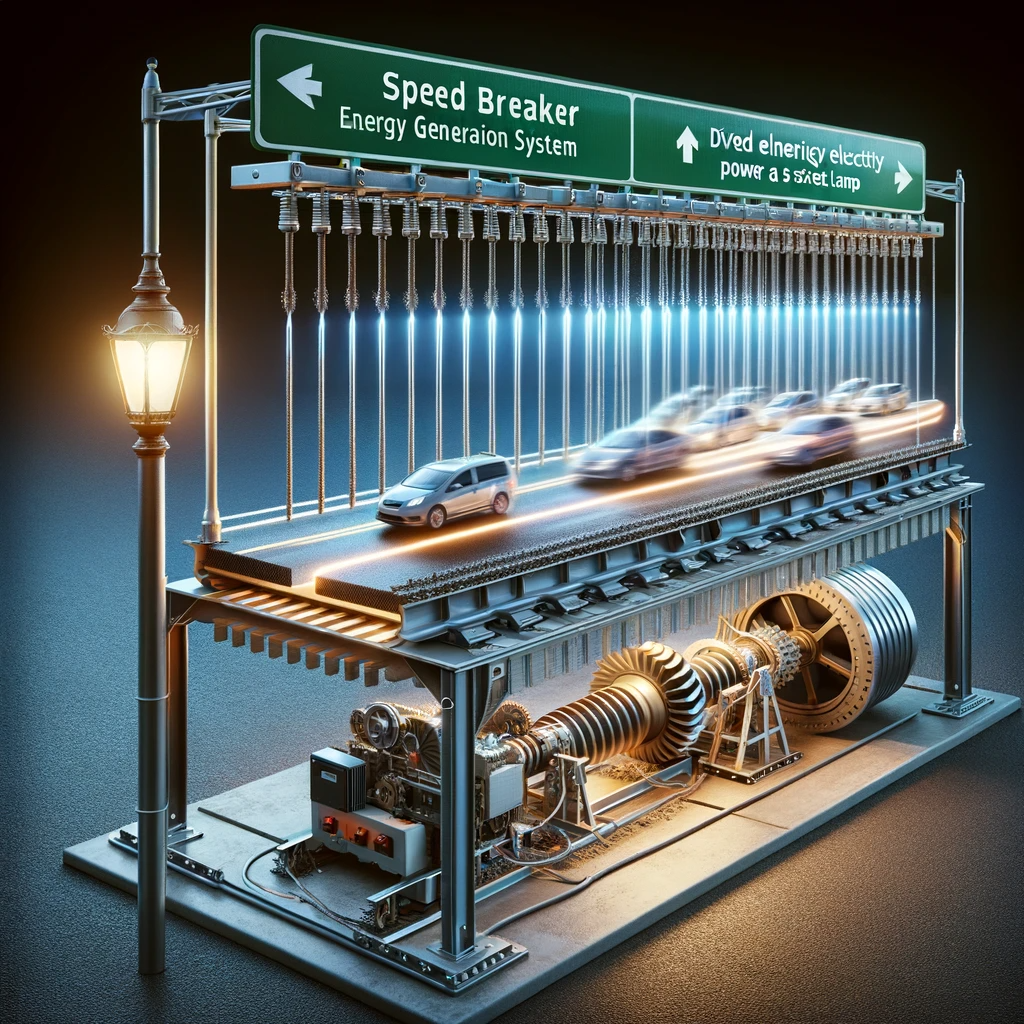Speed Breaker Waste Powe Generation System: The notion of speed breaker waste power generation systems has evolved as a unique and exciting option in the pursuit of creative renewable energy sources. These systems are designed to harness the kinetic energy produced by automobiles when they traverse speed bumps and transform it into electrical energy. This blog post examines the potential, benefits, drawbacks, uses, constraints, and future prospects of speed breaker power generation systems.
Table of Contents
Speed Breaker Waste Powe Generation System Possibilities:
- Mechanical Models: These involve the use of ramps or rollers on speed breakers to capture kinetic energy.
- Hydraulic and Pneumatic Systems: Employing hydraulic or pneumatic mechanisms to harness and convert the energy generated by moving vehicles into electricity.
- Piezoelectric Materials: Utilizing piezoelectric materials under the speed breakers to generate electricity from the pressure exerted by vehicles.

Advantages:
- Renewable Energy Source: Utilizes the non-stop motion of vehicles, a virtually endless resource in busy areas.
- Reduced Carbon Footprint: Helps in reducing reliance on fossil fuels, contributing to environmental sustainability.
- Urban Energy Harvesting: Ideal for cities with heavy traffic, providing an additional energy source without requiring extra space.
Disadvantages and Limitations:
- Inconsistent Energy Production: Energy output depends on traffic volume and can be irregular.
- Maintenance and Durability: Regular maintenance is needed, and these systems must withstand constant wear and tear from vehicles.
- Initial Installation Cost: The initial setup and material costs can be high, and integrating these systems into existing infrastructure can be challenging.
Title: Harnessing Energy from the Streets: The Potential of Speed Breaker Waste Power Generation Systems
Introduction: In the quest for innovative renewable energy sources, the concept of speed breaker waste power generation systems has emerged as a unique and intriguing solution. These systems aim to capture the kinetic energy generated by vehicles passing over speed breakers and convert it into electricity. This blog post explores the possibilities, advantages, disadvantages, applications, limitations, and future scope of speed breaker power generation systems.
Possibilities of Speed Breaker Power Generation:
- Mechanical Models: These involve the use of ramps or rollers on speed breakers to capture kinetic energy.
- Hydraulic and Pneumatic Systems: Employing hydraulic or pneumatic mechanisms to harness and convert the energy generated by moving vehicles into electricity.
- Piezoelectric Materials: Utilizing piezoelectric materials under the speed breakers to generate electricity from the pressure exerted by vehicles.
Advantages:
- Renewable Energy Source: Utilizes the non-stop motion of vehicles, a virtually endless resource in busy areas.
- Reduced Carbon Footprint: Helps in reducing reliance on fossil fuels, contributing to environmental sustainability.
- Urban Energy Harvesting: Ideal for cities with heavy traffic, providing an additional energy source without requiring extra space.
Disadvantages and Limitations:
- Inconsistent Energy Production: Energy output depends on traffic volume and can be irregular.
- Maintenance and Durability: Regular maintenance is needed, and these systems must withstand constant wear and tear from vehicles.
- Initial Installation Cost: The initial setup and material costs can be high, and integrating these systems into existing infrastructure can be challenging.
Applications:
- Urban Street Lighting: Powering streetlights in areas with heavy traffic, especially in urban settings.
- Traffic Signals: Operating traffic lights and signage, reducing the electrical load from the grid.
- Public Facilities: Supporting power needs of nearby facilities such as bus stops, metro stations, or public restrooms.
Future Scope:
The potential for speed breaker power generating systems is highly promising, particularly due to developments in materials science and energy storage. Advancements in piezoelectric materials and enhanced energy storage methods have the potential to enhance the feasibility and cost-efficiency of these systems. Furthermore, the incorporation of intelligent technology to oversee and manage energy generation and distribution could further boost their practicality.
Conclusion:
The utilization of speed breaker waste power generation offers a novel method for capturing renewable energy from routine activities. Despite facing obstacles related to consistency and cost, the topic of urban energy harvesting holds great potential and is worthy of future research and development due to its positive environmental impact. With the progression of technology, these systems have the potential to become an essential component of the urban energy infrastructure.

Add a Comment